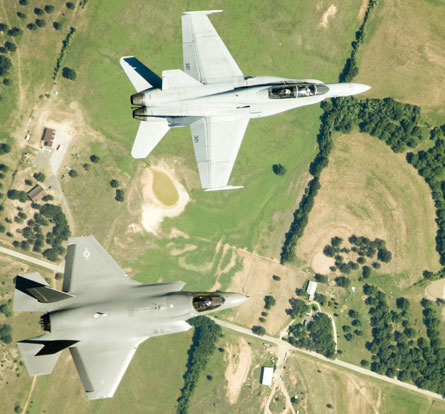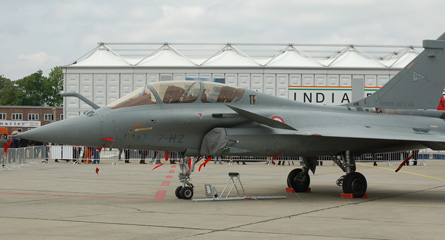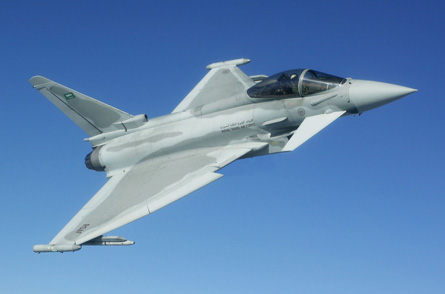With several major fighter contests now nearing a conclusion, last month's Farnborough air show provided a public forum for some of the world's leading manufacturers to trade blows, both in the air and inside the briefing room.
After a period of relatively flat sales activity earlier this decade, the fighter sector is bursting with opportunities, with nations looking to replace aged Western aircraft such as early-model Lockheed Martin F-16s and Northrop F-5s, plus a variety of Soviet-era types.
Farnborough's 60th anniversary will be remembered for a spectacular outburst from the senior US Air Force official responsible for delivering the Lockheed F-35 Joint Strike Fighter programme, and a debut appearance by the Lockheed F-22 Raptor.
Questions were also aired over Europe's planned Tranche 3 deal for the Eurofighter Typhoon, despite the optimistic noises made by the four-nation industry consortium, which still expects to build all 236 aircraft for Germany, Italy, Spain and the UK.
With Lockheed's lone conventional take-off and landing F-35A having only recently been joined in flight test by the programme's first B-model short take-off and vertical landing example, a full-scale mock-up was the most visible display of the nine-nation project.
But high-profile coverage was assured on the eve of the show, when programme executive officer USAF Lt Gen Charles Davis told Flight International that Boeing was "spreading lies and half-truths" about the JSF programme, in what he branded a "desperate and disgraceful" effort to sell its F/A-18E/F Super Hornet. "If Boeing has to say something negative about JSF to sell their aircraft, that tells me there is something wrong with their aircraft," he said.
 |
|---|
© Team JSF |
Boeing and US Navy officials adopted a conciliatory stance. Capt Mark Darrah, the service's F/A-18 programme manager, said: "We will collaborate and work with the JSF: that is the future of carrier aviation." But the incident illustrates the high stakes and aggressive marketing tactics being employed by potential rivals as the F-35 programme battles to overcome schedule delays and cost pressures.
Washington's partnership with Australia, Canada, Demark, Italy, the Netherlands, Norway, Turkey and the UK is firm, but cracks have begun to appear. Some nations, including Denmark and Norway, are considering potential alternatives in case they decide against continuing beyond the JSF project's current system development and demonstration phase.
Boeing has already benefited from slow progress on the F-35, and next year will deliver its first export Super Hornet to Australia. Deliveries of 24 F/A-18F Block II multirole fighters will be completed in 2012, one year before Australia is scheduled to receive its first four of an expected 100 F-35As.
Canberra's Super Hornet acquisition remains a controversial issue in Australia, but suggestions by the nation's previous government that the type could merely provide an interim capability until the F-35's arrival appear unrealistic. "I think they're going to operate them for the next 30-35 years," says Mark Kronenberg, vice-president international business development for Boeing Integrated Defense Systems.
Referring to Davis's comments, Kronenberg says: "The JSF schedule slip is a matter of public record. Our customers are coming back to us, based on where they think the JSF will be, and when it will be delivered, and asking more about what are the capabilities, cost and delivery schedule for a Super Hornet."
Current targets for the Super Hornet include major contests in Brazil and India, plus a late opportunity for Boeing to offer the type to Denmark. Copenhagen is expected to complete a new Strategic Defence Review next February, with this to inform its selection of an F-16 replacement. Competition will also come from Saab's Gripen NG (Next Generation) concept, which has also emerged as a stalking horse for the JSF in the Netherlands and Norway.
"A lot of [JSF partner] countries are looking at each other," says Boeing Military Aircraft president Chris Chadwick, who also cites Canada as a possible future customer. "What we are seeing in Canada is the focus is on getting the right airplane. We see the potential opportunity of competing."
Boeing and Saab are also squaring up in the Brazilian and Indian contests, which both exclude the F-35's involvement.
Seeking deliveries from 2014 under its F-X2 contest, Brazil in June issued requests for information to the two manufacturers, plus Dassault, Eurofighter and Sukhoi, respectively for the Rafale, Typhoon and Su-35. An initial 36 aircraft are required, although follow-on acquisitions could boost this to around 120 fighters.
India's 126-aircraft medium multirole combat aircraft requirement represents the largest export opportunity for the manufacturers of the F-16, Gripen, Rafale (below), Super Hornet, Typhoon and the RSK MiG-35. Worth more than $10 billion, the programme seeks sophisticated equipment including active electronically scanned array radars, with 108 aircraft to be assembled locally.
 |
|---|
© Craig Hoyle/Flight International |
Industrial participation bids are due for delivery in September, with India to launch flight evaluations late this year. A selection is expected in 2010, with options to add 70 aircraft to the massive deal.
Gripen International marketing director Bob Kemp believes some of the bidders struggled to meet the terms of the requirement in their April responses to New Delhi's request for proposals, and says some of his rivals "are hoping the numbers or the budget will shift" to gain compliance.
India has so far given no indication that it will issue a shortlist after assessing the RFP responses and conducting flight evaluations, and given its history of delayed procurement processes, companies may have to decide for themselves whether to stay within a long-running contest.
With so many competitions running in parallel, this is an increasingly common occurrence. Boeing recently withdrew its Super Hornet from Switzerland's F-5 replacement contest, after what Chadwick describes as "a lot of soul searching". The decision left a battle between the Gripen, which is now undergoing a flight evaluation at Emmen air base, and the Rafale and Typhoon. Saab recently signed a partnering agreement with Swiss manufacturer Pilatus to support its campaign.
EADS withdrew the Typhoon from campaigns in Denmark and Norway, and Eurofighter officials are reluctant to pursue a possible opening in the Netherlands before they have received assurances they are entering an open competition. "As far as we know they have already taken a decision: to be part of the JSF programme," says Eurofighter chief executive Aloysius Rauen. "This is a revalidation of a decision already taken."
A Dutch RFP is due in early 2009 for 85 aircraft to enter service from 2015. "Right now they're looking at JSF, but they haven't shut the door," notes Kronenberg, with Boeing promoting the Super Hornet. The Gripen NG is also a candidate for the Dutch deal, as in Norway, which is expected to make a recommendation on its acquisition strategy before year-end. "Our [Norwegian] offer is fully compliant, and we have guaranteed a price," says Kemp.
As well as investing in the JSF, Oslo has provided some funds for Saab's Gripen Demo project, which is showcasing technologies for a future NG-model, also gaining test pilot access to the aircraft. Describing the F-35 as "a bomb truck", Kemp claims: "The Gripen NG will be as good as JSF in many areas, and better in some."
 |
|---|
© Jan Gustafsson/Gripen International |
Saab's Demo programme is the result of an SKr1 billion ($165 million) investment by the company, with this commitment having been matched by several industrial partners. "We are pleased with the flights we have done so far," says Gripen International managing director Johan Lehander. More companies are looking to back the initiative, with no work yet allocated for the planned NG evolution.
While potential new buyers are already being offered design enhancements embodied with the two-seat Demo airframe (above), Kemp stresses: "We are not going to leave our existing operators behind. We will take them with us beyond 2040." Export users include the Czech Republic, Hungary and South Africa, while Thailand also recently signed for six Gripen C/Ds.
Gripen International quotes around 20 other nations as possible future buyers of the Gripen, with its list including countries throughout Asia, Europe, Latin America and the Middle East. "For many years we've been competing with the F-16. Now we're starting to replace it," says Kemp.
But the Swedish design faces stiff competition from larger aircraft such as the Typhoon. Eurofighter's Rauen has long identified Switzerland as the planned third element of a so-called "Alpine triangle" of Typhoon operators, potentially following existing users Germany and Austria.
The last of 148 Tranche 1 production aircraft from the Eurofighter programme was recently handed over, and Tranche 2 deliveries will start later this year. While Italy and the UK last year sought pricing information on possibly halving or cancelling their Tranche 3 orders, Rauen says the planned production of 236 aircraft is intact. "The customer has never taken a decision to cut the numbers," he says.
Negotiations with the NATO Eurofighter and Tornado Management Agency started immediately after May's Berlin air show, and a baseline proposal was submitted on 28 June. "That complete set of documents is on the table with the customer, and we are waiting for feedback on the route to the contract," says Rauen. A signature is sought in late 2008 or early 2009, and he says: "The recent schedule adherence makes us very confident."
Around five of Saudi Arabia's 24 UK-built Typhoons are in final assembly at BAE Systems' Warton plant in Lancashire, and the first - CS001 - may fly before year-end (artist's impression below). Details of a local production deal, widely expected to be with Boeing-backed Alsalam Aircraft, will be confirmed in the near future.
 |
|---|
© BAE Systems |
With an eye on further export opportunities, Eurofighter in early August established a new unit tasked with bringing future capabilities on to the Typhoon. Headed by former chief operating officer programmes Brian Phillipson, the unit represents "a new development approach", says Rauen.
With its Typhoon already on offer to Brazil and India, and pursuing emerging fighter requirements in Greece - which is expected to issue an RFP later this year - and Turkey, Eurofighter is also eyeing Japan's 40-60 aircraft McDonnell Douglas F-4 Phantom replacement programme as a near-term sales opportunity.
An RFP is expected later this year, with Tokyo to look for alternatives after its interest in the F-22 was rejected by the USA, which currently cannot export the aircraft. "The F-22 will not be released internationally in the near term," says Boeing's Chadwick, whose company has a 33% stake in every example produced.
Three Raptors conducted a "flawless" first transatlantic crossing by the type ahead of Farnborough, where one appeared during the opening day's flying display (below). However, Russian sources were underwhelmed by the USAF's demonstration of air superiority, noting that MiG and Sukhoi fighters have demonstrated such manoeuvrability for several years.
 |
|---|
© APG Photography/AirSpace |
The Raptor achieved initial operational capability in June 2006, but the stealth fighter has yet to cut its teeth in combat. However, the USAF says it has performed exceptionally in training, for example scoring a "kill" ratio of 144:0 during a recent Cope Thunder exercise in Canada.
"People are anxious for the aircraft to deploy," notes one F-22 pilot. "But in the close-air support role, would it add value to the guys on the ground? At the moment, the aircraft we have over in Afghanistan and Iraq are perfectly capable."
In the Raptor's absence, the Typhoon and combat-tested Rafale are expected to be offered in Japan, while Boeing will decide whether to offer its Super Hornet or F-15 after seeing the RFP. The company's orderbook for the latter type is currently secure until 2012, with the first of 24 for Singapore to be rolled out in November and a second batch of 21 for South Korea also under contract.
Production of the F/A-18E/F and EA-18G Growler electronic-attack derivative will continue until at least 2014 for the USN, with Boeing having now delivered 357 aircraft from a contracted 493. Company officials expect this orderbook to be extended under a pending third multi-year procurement deal, and also identify Kuwait and other undisclosed Middle East states as potential buyers.
Super Hornets have now logged more than 490,000 flight hours, including over six years of combat operations, and use of the type's new AESA radar has already topped 22,000h. "We are operating in an extremely complex way, and are happy with it," says Darrah.
Source: Flight International























